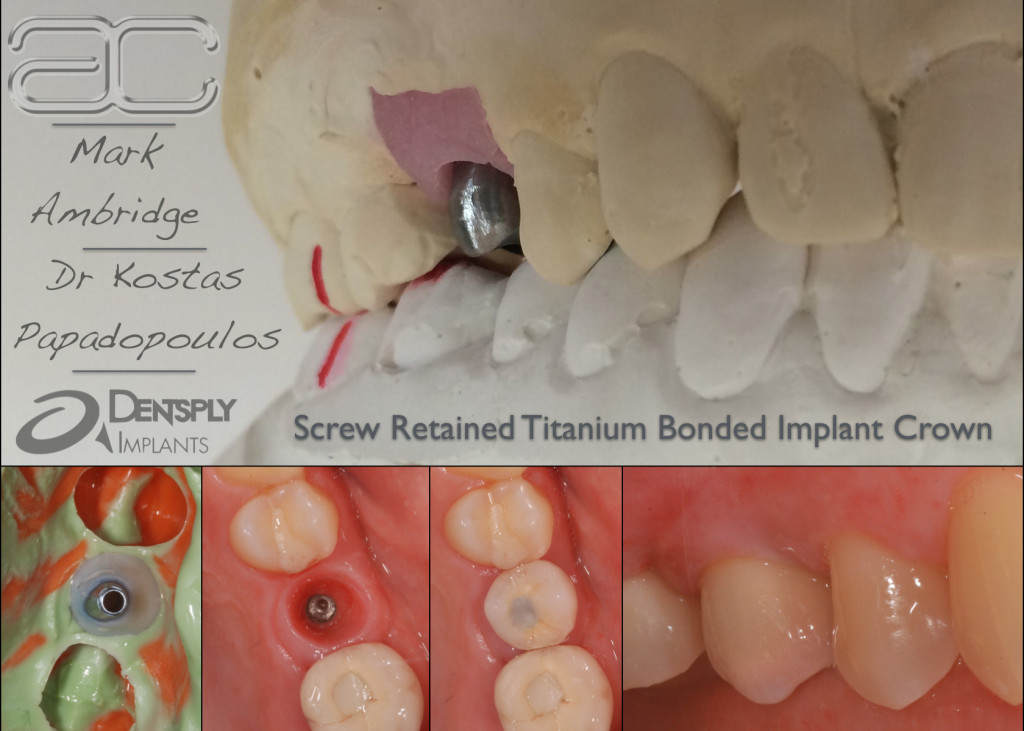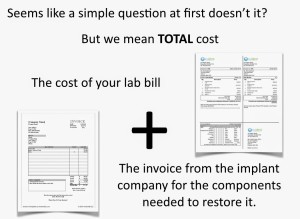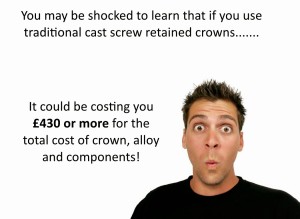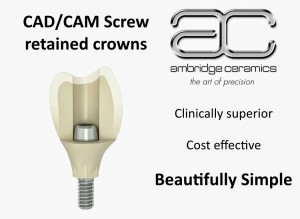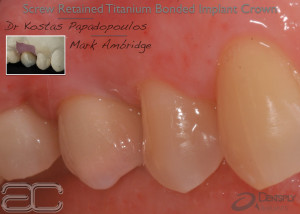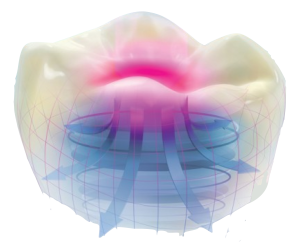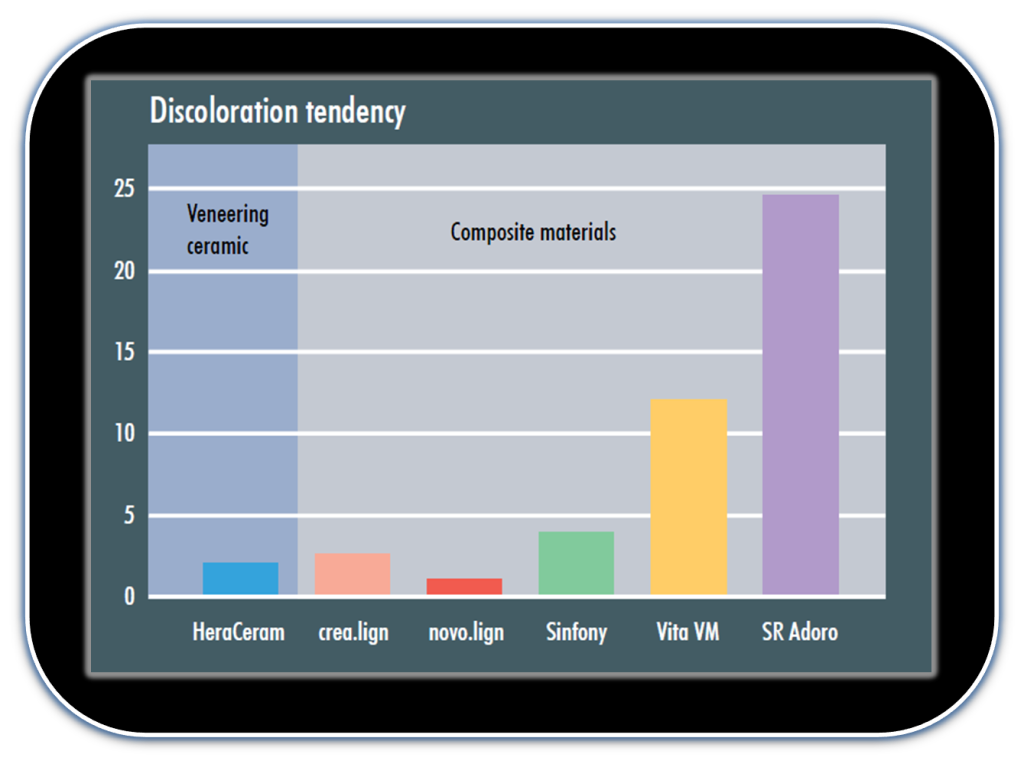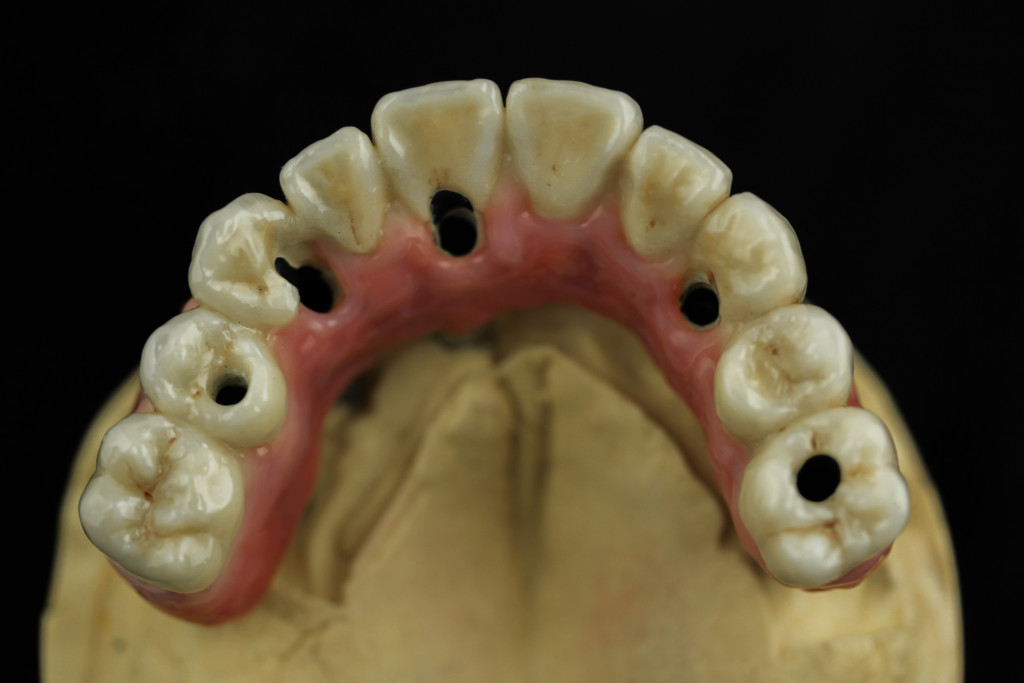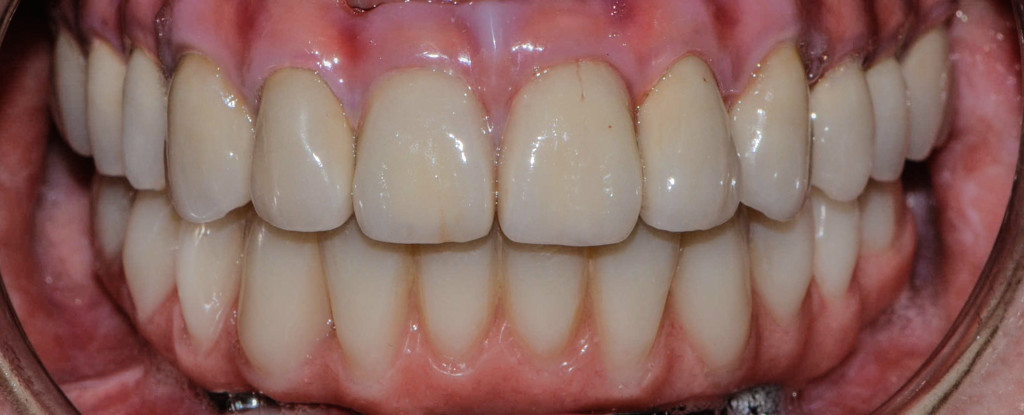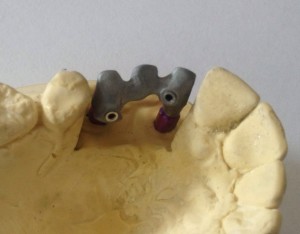Today we are in London for the Official UK launch of the Astra EV implant system!
This will be completely new for most of those attending the exclusive event in London today, but for almost a year now we have been secretly working with Dr Mark Willings and Dentsply in restoring the EV implants that he has been working with as part of the Ambassador program.
The design philosophy of ASTRA TECH Implant System™ EV is based on the natural dentition utilizing a site-specific, crown-down approach supported by an intuitive surgical protocol and a simple prosthetic workflow.

The EV system is an evolution of the already very successful Astra implant system, and now incorporates new design features that improve upon an already class leading and clinically proven implant system.
From a laboratory point of view there is nothing tricky about switching to this system but there are some nice touches, such as a unique index system that will only allow custom made abutments to seat in one position. This is also obviously a huge benefit for the surgeon as they don't have to worry about them seating in one of several possible positions as we do with existing implant systems.

If anything Dentsply have managed to simply improve the user friendly appeal of the already successful Astra system, and build upon the strength and clinically proven results they already provide with the existing implant and restorative range.
It’s been really difficult for us to keep this under our hat as we have naturally been very excited and keen to share the work we have done with the EV implant system. The whole team are honoured to be included in the Ambassador phase of this implant system’s worldwide pre launch roll out and as today is the official launch, we can finally share it with you (although we're not going to share too many details on the systems specifics, we'll leave that to Dentsply)
Here are a few of the many cases we have restored under prescription and guidance of Dr Mark Willings, who was selected from a handful of surgeons worldwide to work with the EV implant system during the pre launch phase.
CASES
It’s obviously a huge honour to be trusted to work on a confidential project such as this one, especially as we have had early access to some of the nice touches that this system brings to the lab when restoring implants, but more importantly for us was the opportunity to feedback on the experience from the lab.
As you would expect we have only used the very best restorative solutions and avoided all potential compromise when dealing with these new EV cases. This has been the Atlantis system for single units and Atlantis ISUS system for multiple unit cases (which is our protocol on all Dentsply implant systems)
The requirement for these cases was that they should be screw retained crowns or bridges, although we do have 1 cement retained case and a couple that were screw retained using lateral fixing screws.
Here is a sneak preview of some selected shots that were taken from the large variety of cases that Dr Willings and others will be presenting today in London. We will also have the final fitted pictures to show after Mark has presented them at the launch today. For now we have the images of the lab work we produced on the new system.
Case 1 - 2 Atlantis abutments with a 3 unit bridge, retained with lateral fixing screws
First we designed 2 Atlantis abutments and then Lee tapped them both to accept Bredent Lateral Fixing Screws. Abutment design and framework by Lee Nichols.

We then produced a framework which is secured into place with the screws. Ensuring we have a screw retained solution and avoid any issues with the access holes coming through the buccal of the restorations.
The screws are slightly flush to the restoration so that after torquing into place the surgeon can trim them flush with the contoured surface of the back of the tooth.
Although this is still screw retained, we have managed to remove the access hole which would have been coming through in the aesthetic zone.
Case 2 - Screw retained molar crown
The final crown that was layered with e.max ceramics by Mark Ambridge

With this case the patient requested a screw retained zirconia crown abutment, so we used the Atlantis system to design a zirconia sub structure that we could layer the ceramic directly onto.

The final abutment was designed and adjusted by Steve Campbell using the Atlantis Web-order Editor interface.

You can see from the image below that we used the Atlantis crown proposal to ensure we provided optimal support for the ceramic on the final crown.
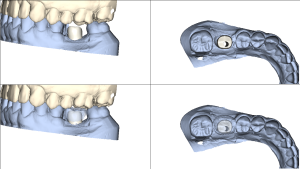
Case 3 - Full arch Atlantis ISUS milled chrome and ceramic layered bridge
This case was a full arch that was scanned and designed from an immediate denture made by Mark Price, which was later converted to an immediate fixed restoration during the patients transition from temporary denture and guide to our final restoration. An effective way of working back from great prosthetic planning, which perfectly matches the EV crown down philosophy.
The final bridge that was layered with Creation ceramic by Jack Gleave.




CAD design stages that show how we used a copy of the immediate restoration which was modified for a more natural tooth emergence by Iain Baldwin, because the immediate had a flange that the patient did not want on the final restoration.

The patient wanted the overall appearance and function copying, so this became our guide. We have made the final guide transparent so that you can see the CAD framework design within.


Here is the CAD proposition of the final framework we received from Atlantis ISUS.

By using Atlantis ISUS we ensure we get a perfect framework to support our final frameworks, we prefer to offer a framework that is clinically proven to offer a superior level of fit which in turn leads to successful long term restorations.

You can see from this image that the new multi unit abutments have a wider diameter implant screw.

I know we've only shared a select few images and cases from all the work we have done here, but I wanted to keep this as brief as possible and just share the experiences and benefits we have had using the new EV system. However after the launch event we will get the final images from Mark and upload the full set and more detailed case write ups in a separate blog
SUMMARY FROM A LAB
Many of the modifications made in the EV system are just nice little adjustments that make the system very easy and predictable to work with and we found no issues at all in the cases we restored.
The biggest noticeable change is a completely new index system that moves from a hex to a spline and allows for easy seating and positive single position only engagement of all Atlantis CAD/CAM restorations, as shown in the image below.


All the components are now colour coded, from pickups and analogues right through to screws, which makes it easy to quickly visually verify you are using the correct components for the EV implant system. Also all the screws have the same 25 Ncm torque value to keep the system simple and user friendly.

There are a wide range of restorative options for the lab, although we have always preferred to stick with the CAD/CAM custom solutions.

Pickup components
Why talk about pickup components in a lab view? Here's why.
One handed self guiding pickup component which will not screw down until correctly engaged
How many times have you cast a model, made a beautiful CAD abutment and crown only to be informed that they were unable to fit it? After casting a new model with a new fixture pickup and comparing with the old cast and impression we find that the rotation and height differ, telling us the initial pickup was not correctly seated.
We're not criticising the surgeons here, traditional implant pickup components are not as user friendly as the EV system and therefore allow for technical errors, especial when having to work in a limited space and with what may not be the most co operative patient.
The Astra Tech EV System has a unique new patented pickup system that means the pickup component is self guiding and will only allow engagement and screw down when it is in the correct position. No more inaccurate implant pickups!

Option for capturing the soft tissue architecture
Again initially this doesn't seem like such a big problem, but from much experience we know of several cases where the surgeon had developed a soft tissue site and the pickup component was so big that all we saw was a big round hole where the nice anatomical tissue site should have been. In effect we had a beautiful replication of a big round pickup cylinder and not the custom tissue site we wanted.
With the Astra Tech EV system they have pickup components that allow for the capture of the cost tissue architecture, and although these are slim when you look at the design of the body and all the facets it incorporates we see that they have actually managed to produce a very retentive surface with a large overall surface area to ensure stability within the impression.
As the vast majority of our abutments are CAD/CAM custom abutments it makes sense that we contour this exactly to the soft tissue architecture that the surgeons have worked so hard to develop, leading to a superior final result for us all.

As shown the reason we are a big fan of the healing abutments is that Dentsply have managed to address the issues that cause technical difficulty or lead to false information on some of the other implant systems.
Site specific healing abutments
This system has a wide range of different healing abutments that are ovoid, round and triangular, ensuring that the surgeon can develop the soft tissue site in a wider range of options that more naturally mimic tooth root shapes than just a standard round pickup.

The reason that we as a lab are so excited and have come to love this system so much is the simple fact that most of the improvements incorporated into this system are technically driven. Therefore designed to eliminate mistakes or mis information that can cause a case we've worked so hard on to either not be fitted or not have the result we would have wanted because the information in the impression was inaccurate in some way, either implant or soft tissue site.
Astra Tech stated that this was a crown down philosophy driven design change and they are absolutely good to their word. We've greatly enjoyed working with this system for a year and look forward to seeing many more come into the lab.
Finally, thank you to the whole lab team who have kept this quiet for so long and worked so hard on all stages of the many cases we have restored over the last year. There were many more ceramic cases by Marc Tocher and Rachelle Webb that we have not shown, along with plenty of work from the team behind the scenes that makes it possible to work on projects like this. Finally we'd also like to thank Dr Willings and Dentsply for choosing us to work with them on a project this big and exciting.
There's more news to come
I’m not about to let the cat out of the bag just yet, but we do have a few more very exciting market leading projects still ongoing. Watch this space!
Want to know more about Astra Tech EV? Here is a link to the pdf



